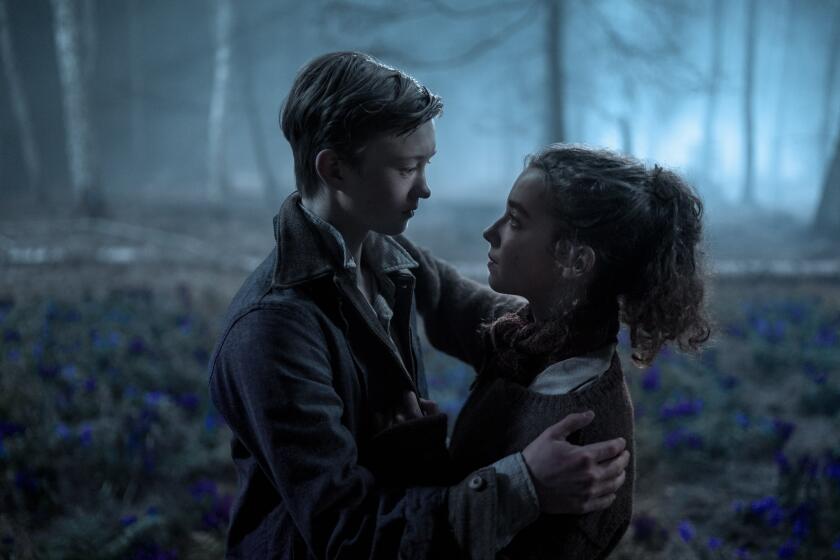‘Last Winter’: Gothic horror rises in Arctic
Freud described the uncanny as the horror that stems from something that feels familiar and unfamiliar at once, caused by the return of something that was concealed or repressed. It’s a feeling that courses through Larry Fessenden’s “The Last Winter,” which is set and partly shot in Alaska’s Arctic National Wildlife Refuge. (The rest was shot in Iceland.) It also sums up the plot of the movie, a contemporary gothic thriller about the perils of messing with nature.
The advance team for an oil company waits for temperatures to drop so that it can start drilling in the formerly protected wilderness preserve, but the weather isn’t cooperating and the members are getting cagey. The permafrost is melting, which is making the ice roads unpassable and releasing into the air all kinds of formerly frozen organisms, viruses and -- who knows? -- the ghosts of the fearsome creatures that roamed the Earth until they died and got mulched into fossil fuels.
The movie opens with a corporate propaganda video that explains that a “historic vote in Congress” has allowed North Industries to send an advance team into the wilderness to study the effect of drilling, bringing us one step closer to energy independence. The presentation ends with the Orwellian-sounding motto, “Trust, risk, results,” which turns out to double as a to-do list for the apocalypse.
North’s advance team members doesn’t radiate quite the level of slick and can-do competence of the company’s promotional materials, however. In fact, they bear more than a passing resemblance to the scrappy space truckers of the Nostromo. (Fessenden was going for “Alien” and John Carpenter’s “The Thing,” mood-wise, and mission accomplished.) The camp mechanic, Motor (the lovably off-putting Kevin Corrigan), spends his days in a cloud of pot smoke; cook Dawn (Joanne Shenandoah) serves grotesque slop and devours romance novels; scientist Elliott (Jamie Harrold) pines for home and spends his day writing e-mails to his mother; young Maxwell (Zach Gilford), whose father thought he could put his love of the outdoors to use by drilling for oil in a pristine setting, seems understandably out of sorts; and the mysterious native Alaskan Lee (Pato Hoffman) does little, says less but smiles to himself like someone who knows something.
Parked in the frozen wilderness with nothing to do, the team members begin to sense that something is wrong. Or maybe it’s just their guilt bubbling to the surface. Either way, Maxwell becomes increasingly unnerved and James Hoffman (James LeGros), the environmental expert hired by North mainly for PR purposes, spends hours holed up in his shack, meticulously transforming his temperature log into a dark record of his terror and confusion. Their trepidation may be inchoate, but it makes perfect sense. As Maxwell remarks, what is oil but fossils, plants and animals from millions of years ago? Millions of years’ worth of buried decay combined with repressed guilt. “Why do we despise the world?” Hoffman writes. “What if the thing we are here to pull out rose up?”
When Ed Pollack (Ron Perlman), the moody, hard-drinking and arrogant team leader, arrives in the camp bearing booze and cheap fiction, he finds that his former lover Abby (Connie Britton) and Hoffman (pun perhaps not intended?) have fallen into a casual relationship built on wary attraction. Hoffman recommends they cancel the project, but Ed charges ahead even after Maxwell, his “charge,” wanders off into the night and returns three hours later, transformed.
It’s billed as an environmental horror story, but “The Last Winter” bears all the hallmarks of an ever-popular genre that has always pitted science, technology and reason against emotion, awe and nature. It bears all the hallmarks of the gothic: ghosts, death, alienated sexuality, decay, secrets, madness and, of course, awe and trepidation in the face of the sublime power of nature. It also accomplishes with a modest budget and a talented cast what bigger, slicker, gorier contemporary horror movies rarely do. It taps into a collective dread compounded by the guilt of our complicity. The scrappy, familiar banality of Fessenden’s vision -- the base camp is a dump, the crew unglamorous, their mission compromised -- only amps up the visceral dread. You know these people wouldn’t stand a chance against nature if it decided to fight back against the parasitic virus that’s destroying it, and you know you wouldn’t, either.
Speaking of things potentially viral, the film is available on demand at the same time it opens in theaters, a strategy that gives a modest movie like “The Last Winter” a better chance of reaching more people. Yes, thawing is bad for the environment. But as far as the film landscape goes, the more stuff bubbles up from the cultural permafrost, the better.
--
“The Last Winter.” MPAA rating: Unrated. Times guidelines: Depictions of gore and violence, including scenes of people on fire. Running time: 100 minutes. Now playing at: The Nuart, West L.A. Also available on demand. (Check local listings for showtimes.)
More to Read
Only good movies
Get the Indie Focus newsletter, Mark Olsen's weekly guide to the world of cinema.
You may occasionally receive promotional content from the Los Angeles Times.










